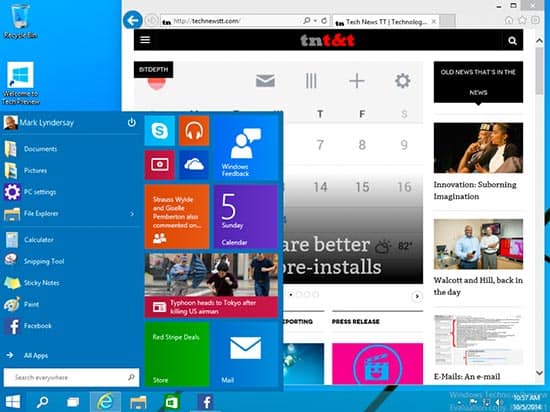
BitDepth#957 for October 07, 2014

Windows 10 includes gracenotes from both version 7 and 8 to create a product that’s a bit of the best of both.
On the very last day of September, Microsoft introduced the newest version of its flagship operating system, Windows 10.
What’s that you might be asking? What happened to Windows 9? Don’t ask, the Internet has already answered that, for the most part with snide humour. Hit a search engine to find out for yourself.
And this isn’t exactly Windows 10, at least not yet. Microsoft makes it clear that this version is subject to change, and the product is still very much under development.
If you decide to play around with it, be aware that it’s a Technical Preview, very much a beta product and one that Microsoft is rather boldly circulating widely in the hopes of gathering feedback about how the product works for its customers.
Since releases like this are normally released only to developers, it’s clear that the company acknowledges the missteps of Windows 8, a brave and largely unwelcomed effort to merge a tablet OS with a desktop interface.
The company has posted a blog with an embedded video that shows off the new design features and approaches.
In the blog, Terry Myerson, Microsoft’s front man for the launch, neatly conflates the blurbs about Windows 8 into the vision of new CEO Satya Nadella: “This new Windows must be built from the ground-up for a mobile-first, cloud-first world.”
The new Windows offers some nuanced touches that are clearly designed to meet the expectations of users who have become comfortable with Windows 8 as well as those who have staunchly resisted upgrading and remain on versions 7 and earlier.
That’s no small figure.
As of July 2014, Windows 8 adoption was 12.5 per cent of Windows installations, compared with over 50 percent for Windows 7.
By September, that number had inched up to 13.37 per cent for both Windows 8 and its healing upgrade, 8.1, but that put the OS just below the widely reviled Windows Vista (14.3) and well below the now formally abandoned Windows XP, which tenaciously holds 23.89 per cent of the Windows install base.
The first thing that the intrepid user will find is the return of a full start menu, not the lame halfway effort included with the 8.1 upgrade.
Not only does it look like the old start menu, it’s actually better, adding selected tile apps to the right of your application launch list, giving users a quick update on what’s been happening in their digital lives.
It’s an inspired use of the Modern UI tile-based interface, so controversially introduced with Windows 8 and you’ll find those apps appearing in more sensible ways as you work through the new OS.
Which isn’t to say that it’s perfect. Some tiles that you’d expect to be live sit silently in the start menu and others update with such speed that it makes the menu a bit dizzying to use. You can also resize it upward, but apparently not sideways
The Task View, a merging of Expose and Spaces on OSX, is an effort at organising app windows, virtual desktops and icons for hard core users, but it’s a bit inconsistent in its execution.
Clicking on the Task View icon or typing Alt Tab gets you the same familiar view of your workspaces, but Windows Tab delivers something quite different for no apparent reason.
There’s also needless conflict between the Start Screen and the Start Menu. Microsoft feels that you should choose one or the other. I have no idea why.
Tile based apps are no longer bound to the digital ghetto of the Start Screen and now launch on the desktop, with their own windows in the desktop interface. This is likely to be a great boon to the developers who committed to creating software for the Windows App Store.
The Windows 10 Technical Preview isn’t for everyone, Microsoft specifically offers the software for “PC experts and IT Pros” through its Windows Insider Programme though users frustrated with Windows 8 may be tempted to go for the new features early.
My own installation, which downloaded briskly and installed even faster in an old VMWare Fusion virtual machine takes up 10GB on disk, not bad for a modern OS installation.
But this is a version of Windows for adventurers, columnists and the technically adept. Using is on a production machine is probably inadvisable, no matter what your friends tell you.
That said, Windows 10 shows far greater promise of becoming that chimeric hybrid that the company was seeking when it released Windows 8 and most compellingly, it’s the product of a company that’s been listening to its customer base. That’s never a bad thing.


